CareCloud CDP Tutorials
Automate Email Warm-ups with CareCloud: Step-by-Step Instructions
By Jan Doleček / 3. 11. 2025 / Tutorials / Automation, Customer Data, E-commerce, Emailing, Loyalty, Retail
Win your customers back with re-engagement campaigns! You can warm up cold customers and revive profitable relationships by using CareCloud email designer, customer data insights, attractive incentives, and automated workflows. Our guide will lead you through the whole process.

WINNING BACK CUSTOMERS WITH AUTOMATION
Brands must avoid high customer churn by carefully nurturing relationships, engaging campaigns, and implementing effective loyalty management. Even when customers stop shopping, there are still ways to reconnect and re-engage them.
One way to win back customers is through automated emailing, which triggers when a customer’s activity stops. With a well-constructed workflow, you can send personalized warm-ups based on customer value to the brand.
Our mock brand, “Vit-LT,” offers a wide range of organic cosmetics, including natural shampoos, skincare products, and body care items. When a customer does not buy for 6 months, an automated Warm-up automation triggers, which brings their activity back through lucrative incentives, distributed according to the customer’s Monetary value (total turnover).
The complete process involves:
- creating multiple emails to revive customers’ activity with rewards.
- segmenting customers into three segments according to their value to the brand.
- designing three voucher rewards suited for the three segments.
- setting up an automation workflow to send emails and vouchers based on the customer’s value to the brand when their activity stops.
EMAIL DESIGN
The first email, “Vit-LT We Miss You,” attempts to reconnect with the customer. We will express our desire to build the relationship further without pushing too hard. To do that, we only need one or two paragraphs, a powerful headline, and a product recommendation.
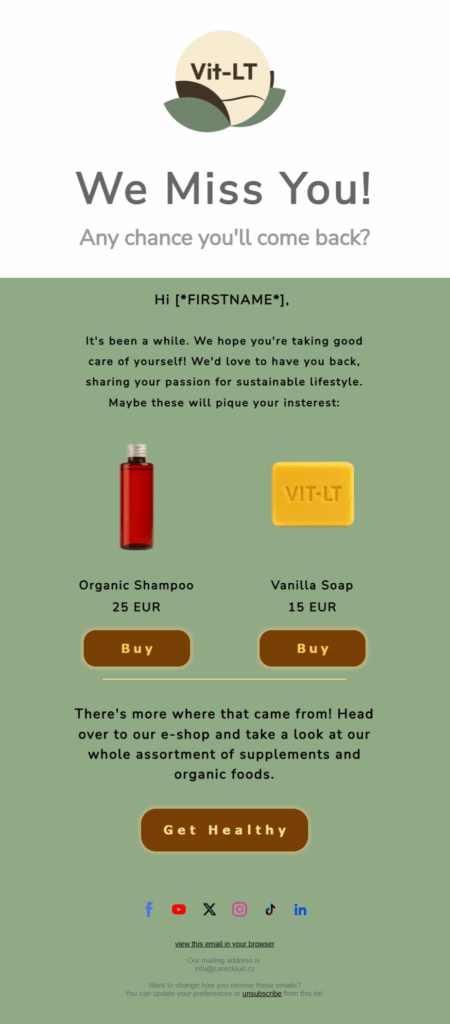
Tip #1: To add products, you can use an XML feed or manually import them. Afterward, you can edit any feature, such as showing item descriptions, editing the layout, etc.
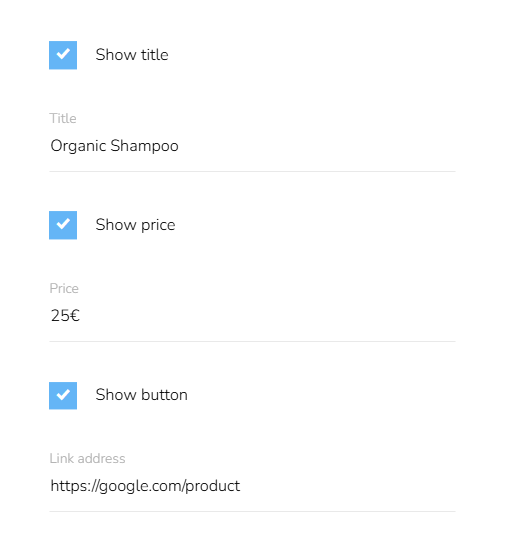
Tip #2: If you have the necessary customer data, use CareCloud AI Recommendation Engine 3.0, which shows products relevant to each customer’s preferences. You can additionally tweak the recommendation model to prefer novelty or diversity.
We will include clear unsubscribe options and links to brand resources (social media, website, etc). Otherwise, make the email short and snappy.
In the next set of emails, we will incentivize customers with a voucher. The message remains the same, except for an added voucher code. Use Personalization variables — Marketing automation variables — Vouchers — Code of the last generated voucher.
We will create three versions of the email, each with a different voucher incentive (10€, 15€, or 20€ off). There is no need to change the template design drastically, because every customer will receive their own personalized email; we will simply change the discount value. Also, each of the three incentive types will have a different minimal order value.
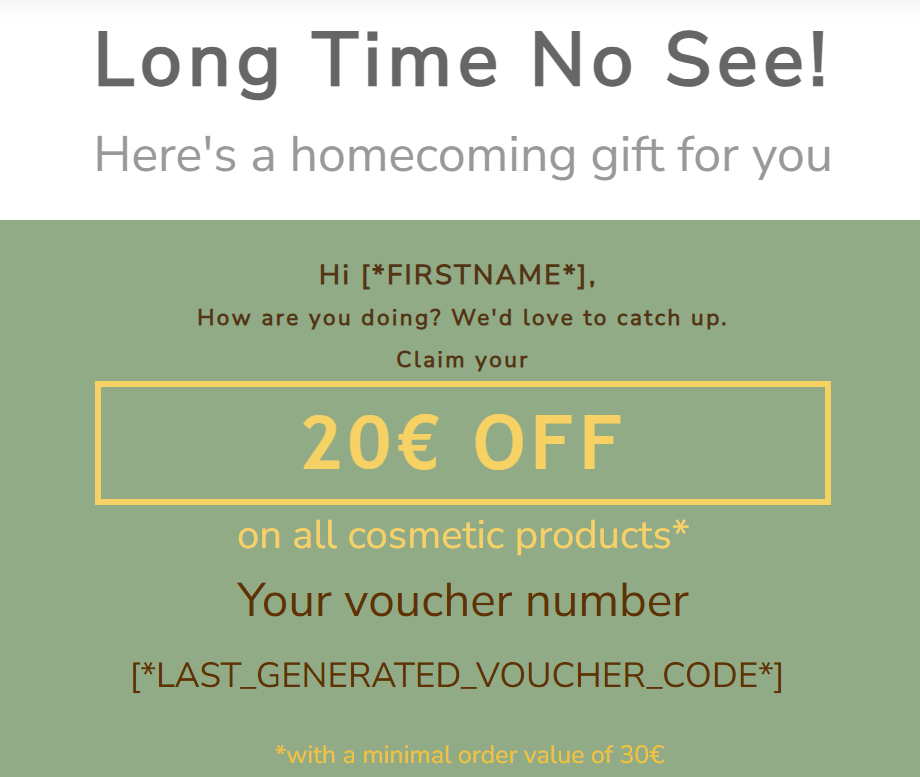
The last email, “Vit-LT, Last Chance,” is a final reminder to redeem the voucher one day before it expires. We will eventually send it one day before the expiration date. Include the countdown timer to leverage urgency.

With emails done, we will proceed with voucher creation.
VOUCHER INCENTIVE
We distribute rewards based on the customer’s total turnover (or Monetary Value in terms of RFM segmentation). Customers will receive a higher reward if they spend enough with our brand.
To distinguish the customer’s “value,” we will use Customer Acquisition Cost. This metric will tell us the average cost of bringing new customers to the brand. The usual formula looks like this:

According to the calculation, the CAC of Vit-LT is 30€. Based on this, we will segment customers’ value into three segments: Lower, Mid, and High Value.
- “Lower Value” customers who spend up to 99€ will receive a 10€ voucher.
- “Mid Value” customers spent from 100-299€ and will receive a 15€ discount voucher.
- “High Value” customers spend over 300€ and receive an exclusive 20€ voucher.
We will create the intended segments in the Loyalty & Administration app. The main settings we look for are the RFM criteria. We will set the Monetary (total turnover) to the values mentioned above. In the Period type, set the interval to cover sufficient time.
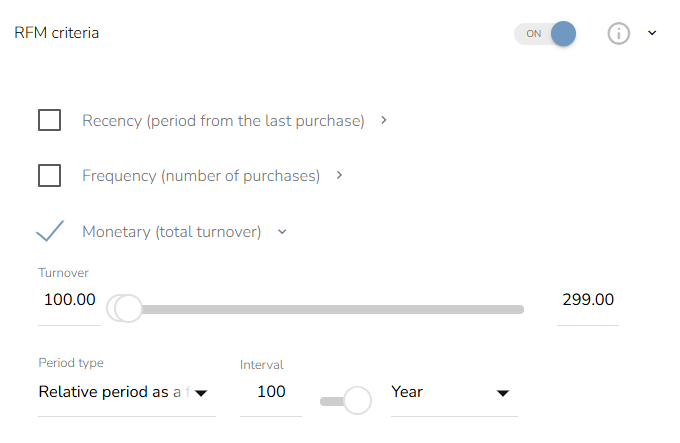
Tip #3: When setting the segments, check the “Flexi” box to ensure continuous reevaluation of who belongs in the segment.

After we’ve completed the three segments, we will move to creating campaign vouchers. We can find them in the Loyalty & Administration app, under Loyalty settings, then Rewards/Vouchers, and finally Campaign Rewards.
We will create three vouchers offering discounts of 10€, 15€, and 20€. The automation logic will trigger the vouchers, so the only conditions we set are the valid products, the requested number of products (with a minimum of 1), the minimum product price, and the time validity.
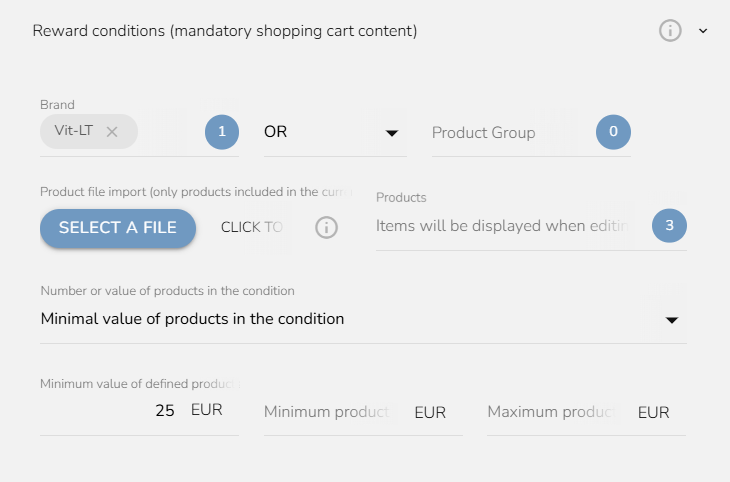
Tip #4: Ensure the time validity of the voucher aligns with the countdown timer in the emails.
Tip #5: Set price conditions for each voucher type. For example, the 15€ voucher is only redeemable for orders with a minimal value of 25€. Scale the minimal order price with every voucher type.
After we create the vouchers, we will finally turn to the automation workflow.
AUTOMATION WORKFLOW
The workflow “Vit-LT Win Back” will combine all elements into a single automated process. The whole logic looks like this:

We will start with the trigger. Unlike event-type triggers, we will use the “Repeat” node to start the workflow monthly at a specific time. We set the workflow to trigger on the third day of the month at 8:00.
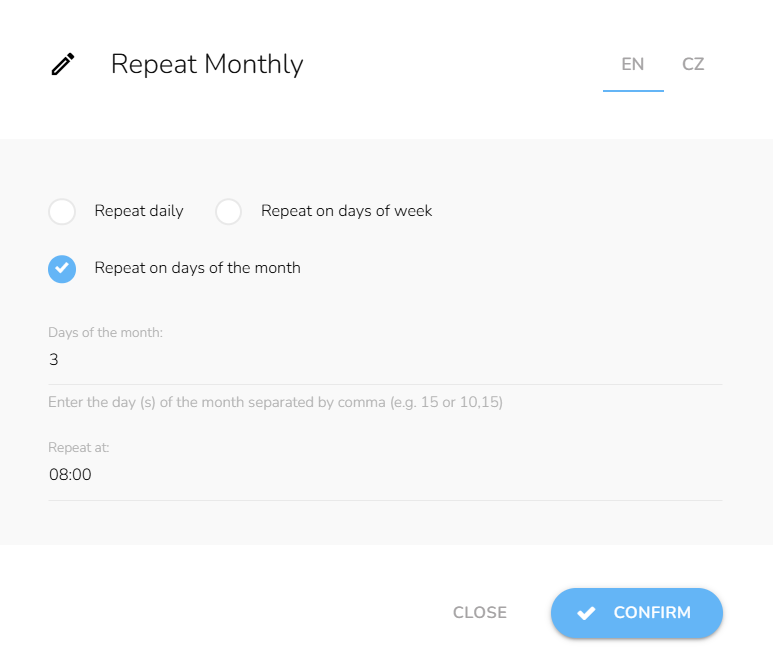
Tip #6: Set the workflow to start early when customers are most likely to engage with your emails.
Afterward, we must ensure that the customer hasn’t purchased in the last six months. Choose the option to “Customers not matching event” and include the “new purchase” event in the last 6 months.
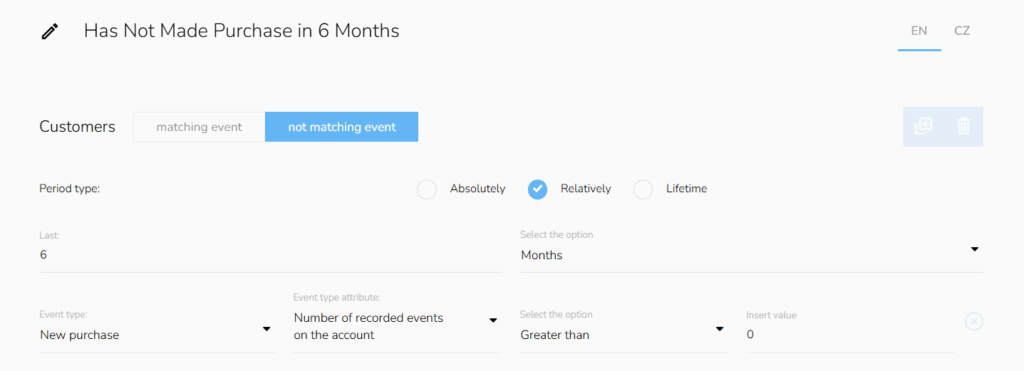
The second part of the condition ensures that the customer hasn’t been targeted with a warm-up workflow recently. Add the condition, but instead of “New purchase,” put “Being Warmed-up.” This will ensure the customer won’t be targeted by two Win Back automations simultaneously.

Tip #7: You can create custom events in Loyalty & Administration. They will help you define your automation workflows and set up actions regarding digital marketing.
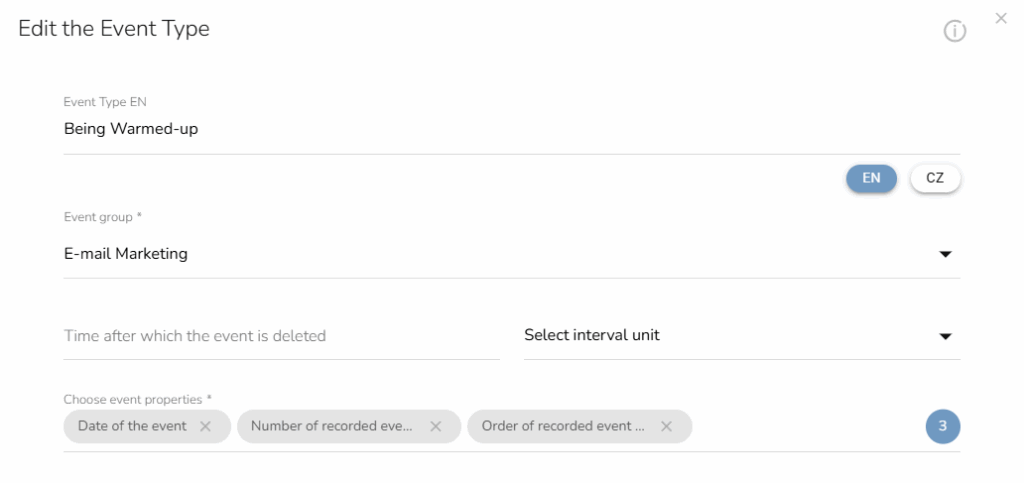
Next, we will send the email “Vit-LT We Miss You” (the version without reward). Since we set the trigger to 8 am, there is no need to put “Wait for time period.” Afterward, we set a three-day waiting period.
Another condition will determine whether the customer has bought in the last three days of being warmed up. The next “Made Purchase?” conditions will have to match the previous waiting period.
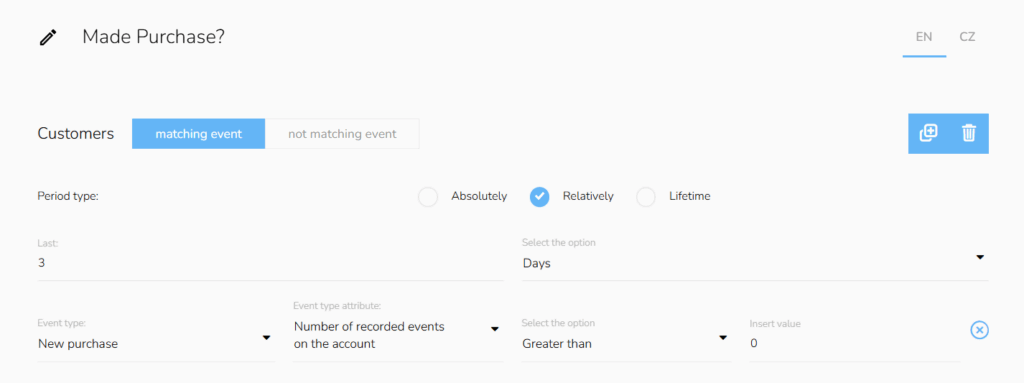
If the customer has bought, the workflow is complete. If not, we will continue determining which reward incentive the customer will receive.
We will set three conditions in sequence to determine our customer’s value. Set the customer attribute to High or Mid (the rest will be Low Value by default). If the customer does not belong to one, put another condition in the “no” branch.
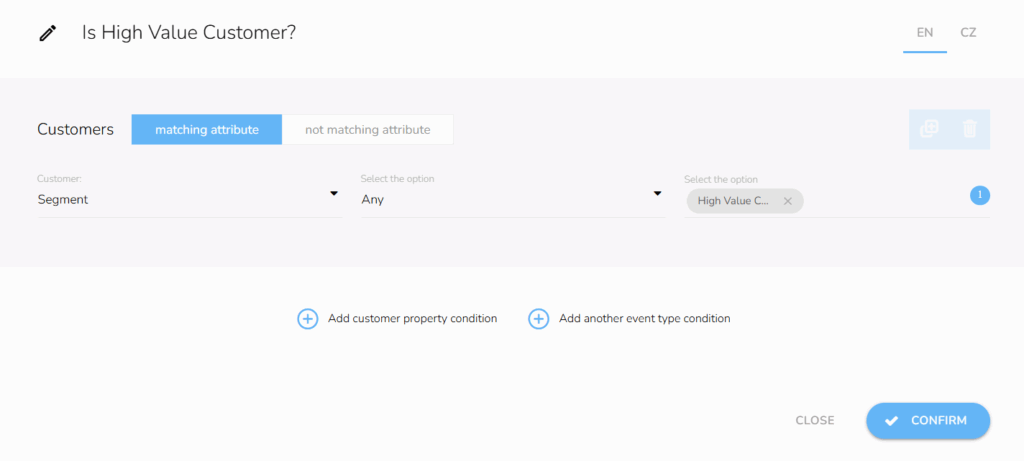
The three emerging “yes” branches will have identical forms, except for the email and voucher assignment. First, assign the campaign voucher we previously created. Then, send the respective email informing customers about their reward (20€, 15€, or 10€).
Afterward, set a waiting period of 9 days (the voucher incentive still has one day until expiration), and add another “Has Bought?” condition. If the customer hasn’t bought yet, send the final “Last Chance Reminder” email.
With the last email reminder, the workflow is concluded.
BRING CUSTOMERS BACK WITH CARECLOUD
It is never too late to restart customer relationships. You only need to properly incentivize the customer and be willing to fight for their engagement. With powerful rewards that are directly aligned with the customer’s value, you can bring them back without losing additional costs or work hours.
Still, the Warm-up workflow is just one way CareCloud apps cooperate to provide a complete digital marketing solution. You can automate advanced abandoned carts, drip campaigns, or restock reminders. Moreover, you can create your loyalty programs and set up impressive campaigns with A/B testing and send time optimization.
Master CareCloud with our hands-on tutorials and skyrocket your ROI.
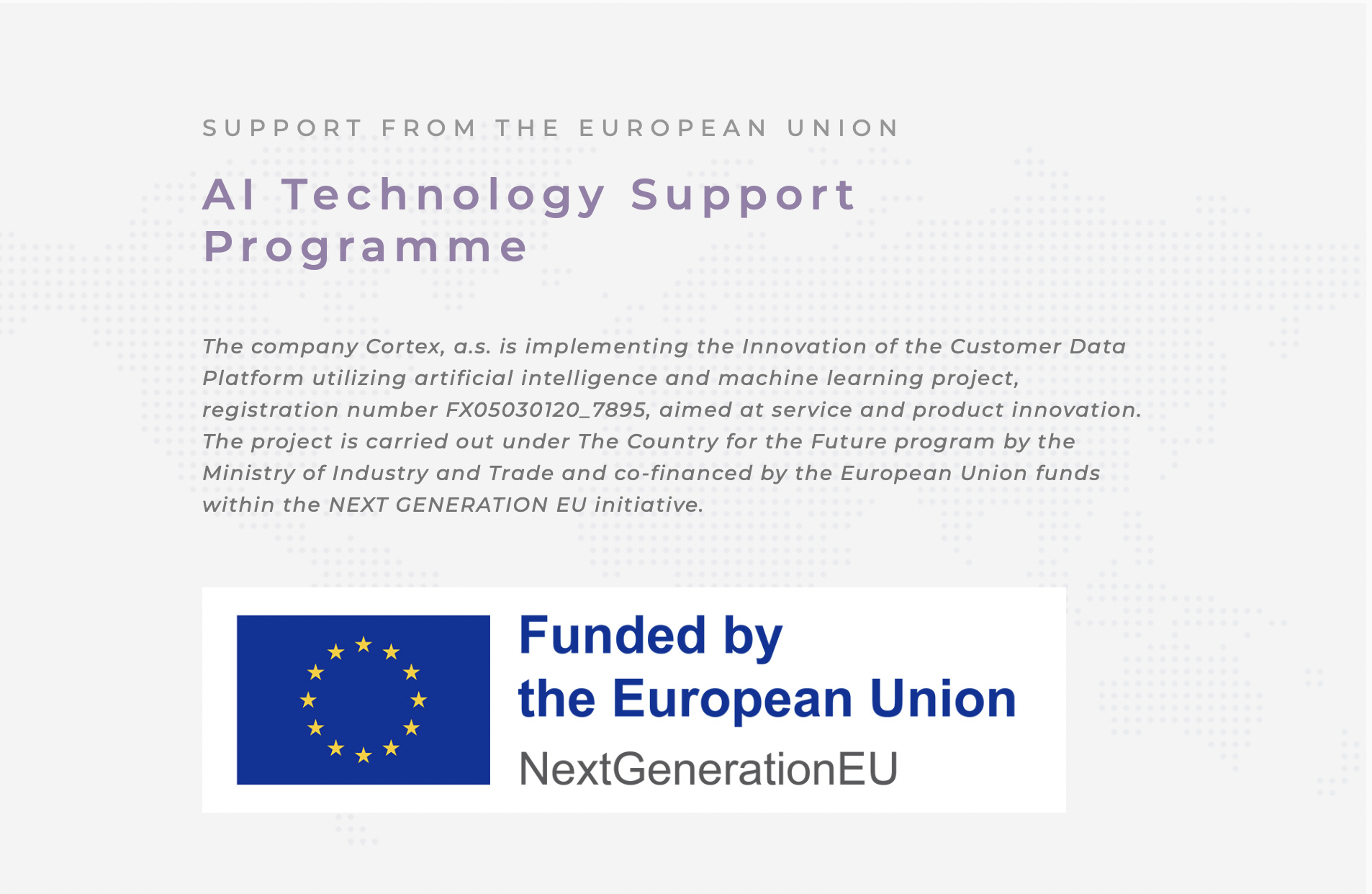
RECOMMENDED
What is hot?
Win your customers back with re-engagement campaigns! You can warm up cold…
Cozy, but insightful — that’s how we’d describe Retail in Detail 2025:…
Push notifications have become an essential part of everyone’s daily routine, keeping…
On 4 September 2025, the Křižík Pavilions hosted Reshoper 2025, where the…
Group Tool Arrange email objects horizontally, such as text, images, or buttons,…
